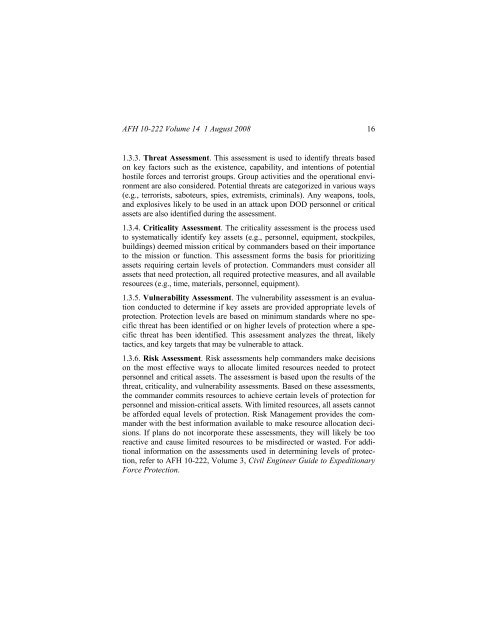Civil engineer guide to fighting positions, shelters, obstacles
Civil engineer guide to fighting positions, shelters, obstacles
Civil engineer guide to fighting positions, shelters, obstacles
You also want an ePaper? Increase the reach of your titles
YUMPU automatically turns print PDFs into web optimized ePapers that Google loves.
AFH 10-222 Volume 14 1 August 2008 16<br />
1.3.3. Threat Assessment. This assessment is used <strong>to</strong> identify threats based<br />
on key fac<strong>to</strong>rs such as the existence, capability, and intentions of potential<br />
hostile forces and terrorist groups. Group activities and the operational environment<br />
are also considered. Potential threats are categorized in various ways<br />
(e.g., terrorists, saboteurs, spies, extremists, criminals). Any weapons, <strong>to</strong>ols,<br />
and explosives likely <strong>to</strong> be used in an attack upon DOD personnel or critical<br />
assets are also identified during the assessment.<br />
1.3.4. Criticality Assessment. The criticality assessment is the process used<br />
<strong>to</strong> systematically identify key assets (e.g., personnel, equipment, s<strong>to</strong>ckpiles,<br />
buildings) deemed mission critical by commanders based on their importance<br />
<strong>to</strong> the mission or function. This assessment forms the basis for prioritizing<br />
assets requiring certain levels of protection. Commanders must consider all<br />
assets that need protection, all required protective measures, and all available<br />
resources (e.g., time, materials, personnel, equipment).<br />
1.3.5. Vulnerability Assessment. The vulnerability assessment is an evaluation<br />
conducted <strong>to</strong> determine if key assets are provided appropriate levels of<br />
protection. Protection levels are based on minimum standards where no specific<br />
threat has been identified or on higher levels of protection where a specific<br />
threat has been identified. This assessment analyzes the threat, likely<br />
tactics, and key targets that may be vulnerable <strong>to</strong> attack.<br />
1.3.6. Risk Assessment. Risk assessments help commanders make decisions<br />
on the most effective ways <strong>to</strong> allocate limited resources needed <strong>to</strong> protect<br />
personnel and critical assets. The assessment is based upon the results of the<br />
threat, criticality, and vulnerability assessments. Based on these assessments,<br />
the commander commits resources <strong>to</strong> achieve certain levels of protection for<br />
personnel and mission-critical assets. With limited resources, all assets cannot<br />
be afforded equal levels of protection. Risk Management provides the commander<br />
with the best information available <strong>to</strong> make resource allocation decisions.<br />
If plans do not incorporate these assessments, they will likely be <strong>to</strong>o<br />
reactive and cause limited resources <strong>to</strong> be misdirected or wasted. For additional<br />
information on the assessments used in determining levels of protection,<br />
refer <strong>to</strong> AFH 10-222, Volume 3, <strong>Civil</strong> Engineer Guide <strong>to</strong> Expeditionary<br />
Force Protection.
















